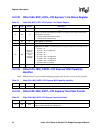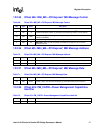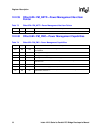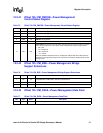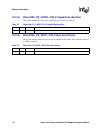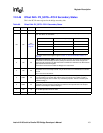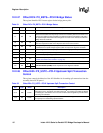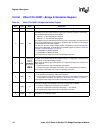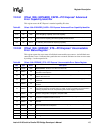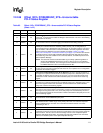
104 Intel
®
41210 Serial to Parallel PCI Bridge Developer’s Manual
Register Description
12.2.50 Offset FCh: BINIT—Bridge Initialization Register
Table 84. Offset FCh: BINIT—Bridge Initialization Register
Bits Type Reset Description
31:5 RO 000 0000h Reserved
4RWS 0b
Opaque Memory Window Enable: When this bit is set, the Intel
®
41210 Serial to Parallel
PCI Bridge hard-codes certain address ranges to the
secondary segment of each bridge.
The hard-coded address ranges are as follows:
• A[63:62] = 10 secondary side of A-segment
• A[63:63] = 11 secondary side of B-segment
This address range is forwarded from the primary to the corresponding secondary side and
also is never forwarded from the secondary to the primary side, irrespective of the setting of
the prefetchable base and limit registers.
Note that even when the opaque memory window is enabled, the normal 41210 behavior
defined for the BME, MSE, and IOSE bits in the PCICMD register are still true (“Offset 04h:
PCICMD—Command Register” on page 78).
0 = Opaque Memory Window disabled
1 = Opaque Memory Window enabled
Each segment of the bridge uses the bit corresponding to that side.
3RW
Varies with
external
state of
CFGRETRY
pin on rising
edge of
PERST#
Configuration Cycle Retry:
When set, this bit results in a configuration retry response on
the Intel
®
41210 Serial to Parallel PCI Bridge for all Type 0 configuration transactions from
PCI Express* to the internal bridge registers.
When this bit is cleared, Type 0 transactions are completed normally to the internal 41210
bridge registers.
0 = Normal response to Type 0 configuration transactions
1 = Response to Type 0 configuration transaction is the Configuration Retry Response.
Each segment of the bridge uses the bit corresponding to that side.
2RWS 0b
Device Hiding Enable: This bit enables hiding of devices on the secondary PCI bus:
0 = All downstream devices are visible to all requestors.
1 = Device numbers 0 to 9 on the immediate secondary bus are hidden from downstream
configuration transactions. See Section 5.2, “Secondary PCI Devices” on page 42.
Each segment of the bridge uses the bit corresponding to that side.
1RWS 1b
Upstream Configuration Enable: This bit controls the behavior for upstream configuration
transactions allowing local initialization from the secondary PCI-X interface:
0 = Upstream configuration transactions are not claimed.
1 = Upstream configuration transactions with AD[16] = 1 are claimed.
Each segment of the bridge uses the bit corresponding to that side.
0RWS 1b
Upstream I/O Enable: When set, this bit enables I/O transactions from PCI. The I/O
transactions are enabled by default.



